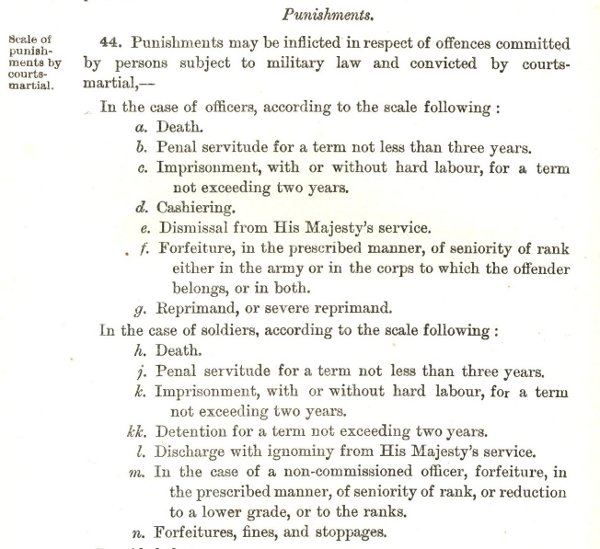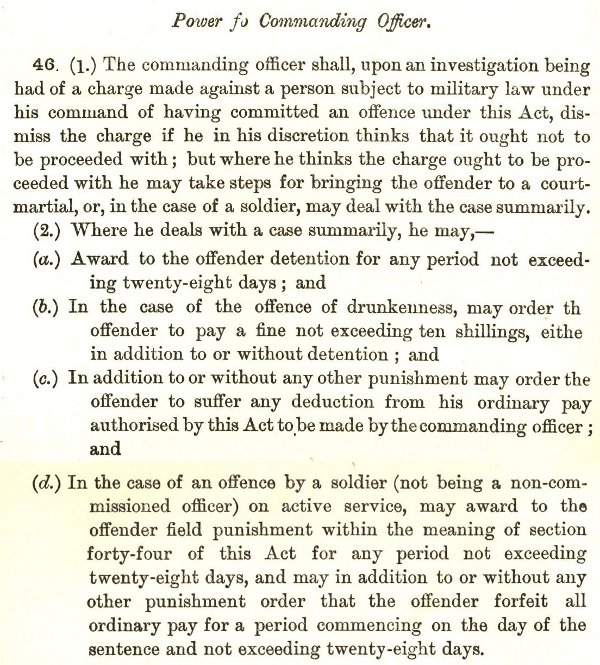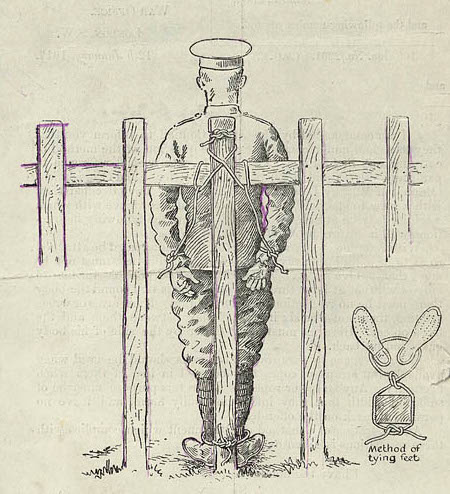
Researching Canadian Soldiers of the First World War
Part 16: … and Punishment
By Michael O'Leary; The Regimental Rogue
Introduction
When it is decided to tie a prisoner to a fixed object, it has been found advisable to carry out this punishment in as public a place as possible.
The Canadian Officer's Guide To The Study of Military Law, by Major E. W. Pope, The RCR, 1916
As with our modern court systems, the execution of Courts Martial and Summary Trials during the First World War do not support a simplistic correlation between specific charges and matching punishments. The simplistic description of charges as commonly found in regimental documents or individual service records do not include the many other factors and mitigating circumstances which may affect the severity of sentencing. Where Part 15 of this series, "Crime …", introduced some of the many offences for which a soldier might be tried, this section will examine the nature of the punishments which might be awarded for those crimes.
Punishments Awarded by Court Martial
Courts Martial were given specific powers of punishment authorized by the Army Act, set out in the King's Regulations and Orders (download the 1917 edition), and further expanded upon in the Manual of Military Law. These regulations and guidelines ensured that the many Courts Martial held within the Canadian Expeditionary Force, and Canadian soldiers undergoing Courts Martial conducted by officers of the British Army, could expect to receive punishments drawn from a single scale applicable to all cases.

Scale of Punishments by Courts Martial, as published in the Army Act 1913, excerpted from the Manual of Military Law, War Office publication, 1914. (See the full article in one image.)
The following table is presented as an example of the punishments which might be awarded by Court Martial. The table identifies the types of punishment (in order of decreasing severity of punishment), including minimum and maximum sentences for 133 Courts Martial of soldiers of The Royal Canadian Regiment during the First World War. In some cases, the lesser punishments shown were in addition to other punishments awarded.
133 Courts Martial; Breakdown of Punishments - The Royal Canadian Regiment
| Punishment | Number of instances of punishment awarded | Minimum sentence awarded in cases examined | Maximum sentence awarded in cases examined | Remarks |
|---|---|---|---|---|
| Death | 2 | Both commuted to Imprisonment | ||
| Penal Servitude. | 8 | 5years | 20 years | |
| Imprisonment with Hard Labour | 19 | 4 months | 5 years | |
| Imprisonment without Hard Labour | 2 | 6 months | 2 years | |
| Detention | 5 | 168 hrs | 2 years | |
| Demoted | 26 | e.g., From Sgt to Cpl | ||
| Field Punishment No. 1 | 68 | 7days | 90 days | |
| Forfeits Pay | 3 | e.g., 14 days |
Court Martial punishments can be found in the applicable Courts Martial records, in the unit Part II Daily Orders or in the soldier's service record.

An example entry of a Court Martial trial result of 454807 Private Amedie Lascelle, from the Part II Daily Orders of The Royal Canadian Regiment.
(I.H.L. = Imprisonment with Hard Labour.)
Punishments Awarded by Summary Trials
The following excerpt from the Manual of Military Law (1914) shows quite clearly that the powers of punishment awarded to a Commanding Officer (CO) were significantly less that those permitted by a Court Martial. For this reason, for two men charged with the same offence (in varying degrees), one might be tried by his CO, and the other sent to Court Martial because the CO did not believe his powers of punishment were sufficient if he found the man guilty of the offence.

Scale of Punishments by Commanding Officers, as published in the Army Act 1913, excerpted from the Manual of Military Law, War Office publication, 1914. (See the full article in one image.)
The following table shows the punishments awarded for 1349 summary trials of the same unit
1349 Summary Trials; Breakdown of Punishments - The Royal Canadian Regiment
| Punishment | Number of instances of punishment awarded | Minimum sentence awarded in cases examined | Maximum sentence awarded in cases examined | Remarks |
|---|---|---|---|---|
| Field Punishment No. 1 | 370 | 1 day | 28 days | |
| Mulct Pay | 325 | |||
| C.B | 173 | 3 days | 14 days | Confined to Barracks (Base, Billets, Camp, etc.) |
| Forfeits Pay | 162 | 1 day | 28 days | |
| Fine | 66 | $2.00 | $6.00 | |
| Detention | 59 | 10 days | 28 days | |
| Severely Reprimanded | 50 | |||
| Admonished | 44 | |||
| Field Punishment No. 2 | 39 | 2 days | 28 days | |
| Stoppage of Pay | 27 | 1 shilling | £ 6 - 9 - 7 1/2d | |
| Deprived of Lance stripe | 18 | |||
| Reprimanded | 6 | |||
| Deprived of Acting Lance stripe | 4 | |||
| Demotd | 4 | |||
| Deprived of Acting Rank | 1 | |||
| Reverts to Permanent Grade of Corporal. | 1 |
Field Punishment
Of all the natures of punishment identified above, the one which is least likely to be familiar to a modern researcher in Field Punishment. The following excerpt from The Canadian Officer's Guide To The Study Of Military Law provides a description of this style of punishment which was applied quite frequently during the First World War.
Excerpt from: The Canadian Officer's Guide To The Study Of Military Law, by Major E. W. Pope, The Royal Canadian Regiment, Methuen & Co. L Td. 36 Essex Street W .C., London, 1916
CHAPTER XIV - RULES FOR FIELD PUNISHMENT AND THE KEEPING OF CONDUCT SHEETS
(See M.M.L. p. 721, and F.S.R. Pt. II, chapter on "Discipline")
109. I. For any offence committed on active service an offender may be sentenced, by his commanding officer, to twenty-eight days' Field Punishment, and by a Court Martial to three months' Field Punishment.
Field Punishment is of two kinds:
(a) Field Punishment No. 1.
(b) Field Punishment No. 2.
2. Where an offender is sentenced to Field Punishment No. I, he may, during the continuance of his sentence, unless the Court Martial or the commanding Officer otherwise directs, be punished as follows:
(a) He may be kept in irons, i.e. in fetters or handcuffs, or both fetters and handcuffs; and may be secured so as to prevent his escape.
(b) When in irons he may be attached for a period or periods not exceeding two hours in anyone day to a fixed object, but he must not be so attached during more than three out of any four consecutive days, nor during more than twenty-one days in all.
(c) Straps or ropes may be used for the purpose of these rules in lieu of irons.
(d) He may be subjected to the like labour, employment, and restraint, and dealt with in like manner, as if he were under a sentence of imprisonment with hard labour.

A contemporary diagram showing one possible manner of securing a soldier to a fixed object for the administration of Field Punishment No. 1.
(Source: Unknown.)
3. Where an offender is sentenced to Field Punishment No. 2, the foregoing rule with respect to Field Punishment No. 1 shall apply to him, except that he shall not be liable to be attached to a fixed object as provided by paragraph (b) of Rule 2.
4. Every portion of a Field Punishment shall be inflicted in such a manner as is calculated not to cause injury or to leave any permanent mark on the offender; and a portion of a Field Punishment must be discontinued upon a report by a responsible medical officer that the continuance of that portion would be prejudicial to the offender's health.
5. Field Punishment will be carried out regimentally when the unit to which the offender belongs or is attached is actually on the move, but when the unit is halted at any place where there is a provost marshal or an assistant provost marshal the punishment will be carried out under that officer.
6. When the unit to which the offender belongs or is attached is actually on the move, an offender awarded Field Punishment No. 1 shall be exempt from the operation of Rule 2. (b), but all offenders awarded Field Punishment shall march with their unit, carry their arms and accoutrements, perform all their military duties as well as extra fatigue duties, and be treated as defaulters.
110. Method of carrying out Field Punishment. Although it has not been considered advisable to allow Field Punishment No. 1 to be administered in the United Kingdom, it is the punishment most frequently met with in the theatre of war. It is easily carried out, if the proper procedure is understood, and has been administered with excellent results. It must be remembered for obvious reasons that a man undergoing Field Punishment does not thereby miss his tour of duty in the trenches. No punishments are carried out when the unit is actually on trench duty, and since the sentence runs concurrently with this duty due attention should be paid to this point by the Commanding Officer in making his award. Many officers have an idea that Field Punishment No. I consists in merely tying a prisoner to a fixed object for a certain length of time each day. This is quite wrong. The proper system is to make a man sentenced to this punishment do all the fatigues and sanitary work possible in the vicinity of the billets which his unit is occupying, with a view to relieving well-conducted men there-from. Then when there is nothing left for him to do of that nature, he can be tied to a fixed object for a period not exceeding two hours daily. When it is decided to tie a prisoner to a fixed object, it has been found advisable to carry out this punishment in as public a place as possible.
Researching Canadian Soldiers of the First World War
- Introduction
- Part 1: Find your Man (or Woman)
- Part 2: The Service Record
- Part 3: Court Martial Records
- Part 4: War Diaries and Unit Histories
- Part 5: Casualties
- Part 6: Researching Honours and Awards
- Part 7: Deciphering Battlefield Location Information
- Part 8: More Mapping Information
- Part 9: Matching Battlefield Locations to the Modern Map
- Part 10: Service Numbers; More than meets the eye
- Part 11: Rank, no simple progression
- Part 12: Medals; Pip, Squeak, Wilfred and the whole gang
- Part 13: Evacuation to Hospital
- Part 14: The Wounded and Sick
- Part 15: Crime …
- Part 16: … and Punishment
- Part 17: Battalions and Brigades, Companies and Corps
- Part 18: Photo Forensics: Badges and Patches
- Part 19: Veterans Death Cards
- Part 20: The Vimy Pilgrims (1936)

- The O'Leary Collection; Medals of The Royal Canadian Regiment.
- Researching Canadian Soldiers of the First World War
- Researching The Royal Canadian Regiment
- The RCR in the First World War
- Badges of The RCR
- The Senior Subaltern
- The Minute Book
- Rogue Papers
- Tactical Primers
- The Regimental Library
- Battle Honours
- Perpetuation of the CEF
- A Miscellany
- Quotes
- The Frontenac Times
- Site Map
QUICK LINKS
- Tomb of the Unknown Soldier
- Vimy Memorial
- Dieppe Cemetery
- Perpetuation of CEF Units
- Researching Military Records
- Recommended Reading
- The Frontenac Times
- RCR Cap Badge (unique)
- Boer War Battles
- In Praise of Infantry
- Naval Toast of the Day
- Toasts in the Army (1956)
- Duties of the CSM and CQMS (1942)
- The "Man-in-the-Dark" Theory of Infantry Tactics and the "Expanding Torrent" System of Attack
- The Soldier's Pillar of Fire by Night; The Need for a Framework of Tactics (1921)
- Section Leading; A Guide for the Training of Non-Commissioned Officers as Commanders and Rifle Sections, 1928 (PDF)
- The Training of the Infantry Soldier (1929)
- Modern Infantry Discipline (1934)
- A Defence of Close-Order Drill (1934): A Reply To "Modern Infantry Discipline"
- Tactical Training in the British Army (1901)
- The Promotion and Examination of Army Officers (1903)
- Discipline and Personality (1925)
- The Necessity of Cultivating Brigade Spirit in Peace Time (1927)
- The Human Element In War (1927)
- The Human Element In Tanks (1927)
- Morale And Leadership (1929)
- The Sergeant-Major (1929)
- The Essence Of War (1930)
- Looks or Use? (1931)
- The Colours (1932)
- Personality in Leadership (1934)
- Origins of Some Military Terms (1935)
- Practical Examination; Promotion to Colonel N.P.A.M. (1936)
- Company Training (1937)
- Lament Of A Colonel's Lady (1938)
- Morale (1950)
- War Diaries—Good, Bad and Indifferent
- Catchwords – The Curse and the Cure (1953)
- Duelling in the Army
- Exercise DASH, A Jump Story (1954)
- The Man Who Wore Three Hats—DOUBLE ROLE
- Some Notes on Military Swords
- The Old Defence Quarterly (1960)
- Military History For All (1962)
- Notes for Visiting Generals (1963)
- Hints to General Staff Officers (1964)
- Notes for Young TEWTISTS (1966)
- THE P.B.I. (1970)
- Standing Orders for Army Brides (1973)
- The Time Safety Factor (1978)
- Raids (1933)
- Ludendorff on Clerking (1917)
- Pigeons in the Great War
- Canadian Officer Training Syllabus (1917)
- The Tragedy of the Last Bay (1927)
- The Trench Magazine (1928)
- Billets and Batman (1933)
- Some Notes on Shell Shock (1935)
- Wasted Time in Regimental Soldiering (1936)
- THE REGIMENT (1946)
- The Case for the Regimental System (1951)
- Regimental Tradition in the Infantry (1951)
- The Winter Clothing of British Troops in Canada, 1848-1849
- Notes On The Canadian Militia (1886)
- Re-Armament in the Dominions - Canada (1939)
- The Complete Kit of the Infantry Officer (1901)
- The Canadian Militia System (1901)
- The Infantry Militia Officer of To-day and His Problems (1926)
- Personality in Leadership (1934)
- British Regular Army in Canada
- Battle Honours (1957)
- Defence: The Great Canadian Fairy Tale (1972)
- The Pig (1986)
- Standing Orders for the Fortress of Halifax, N.S.; 1908
- Medals and Badges - Fakes and Copies
- Army Punishments Part 1 - • Part 2
• C.A.R.O. No. 6719 - Campaign Stars, Clasps, The Defence Medal and the War Medal 1939-45
[an error occurred while processing this directive]
[an error occurred while processing this directive]
[an error occurred while processing this directive]